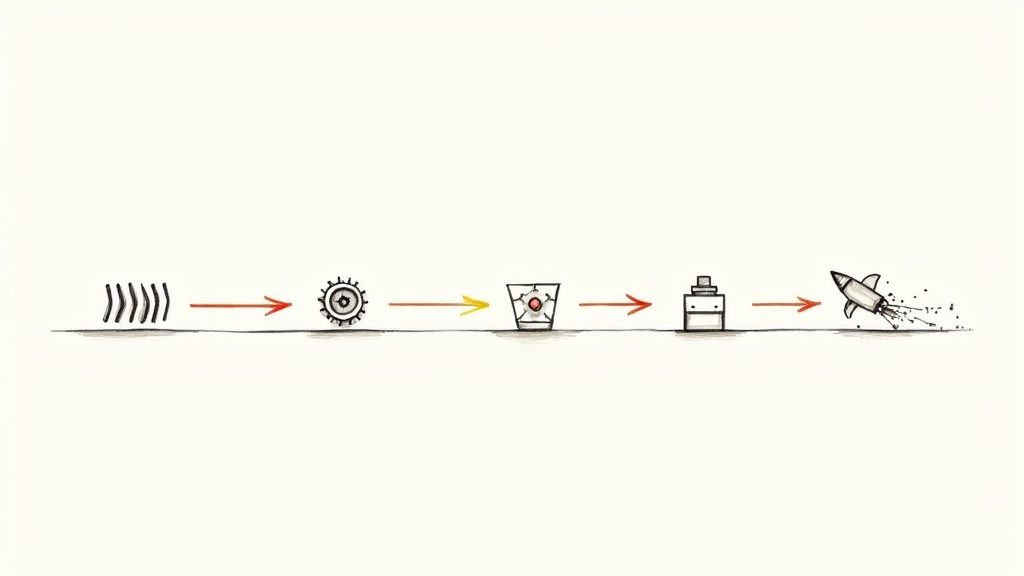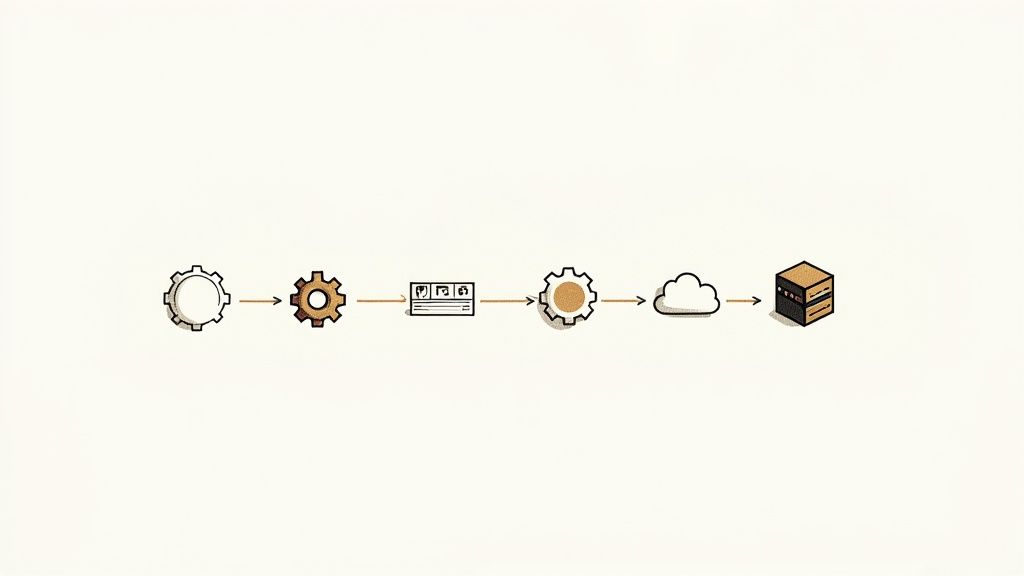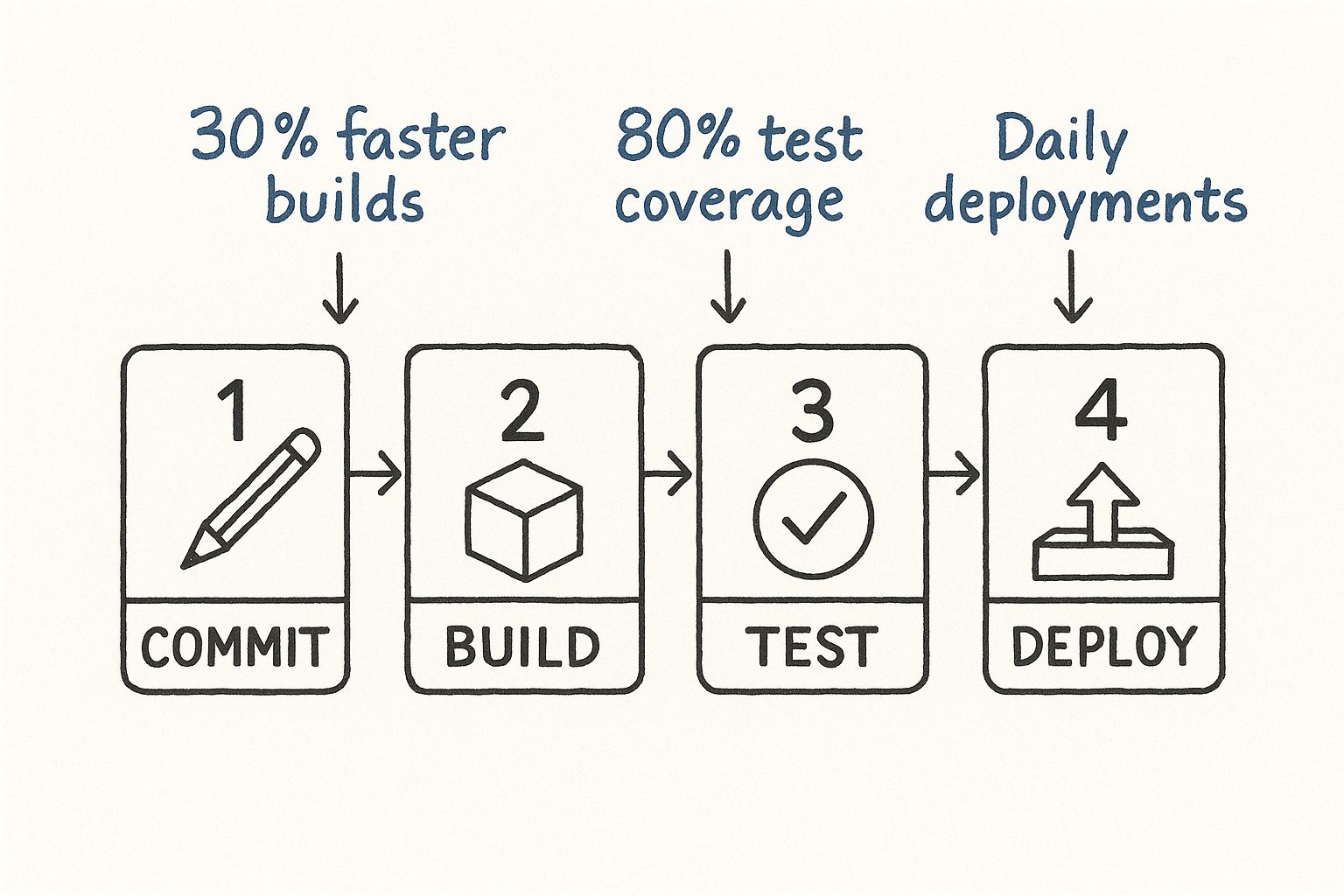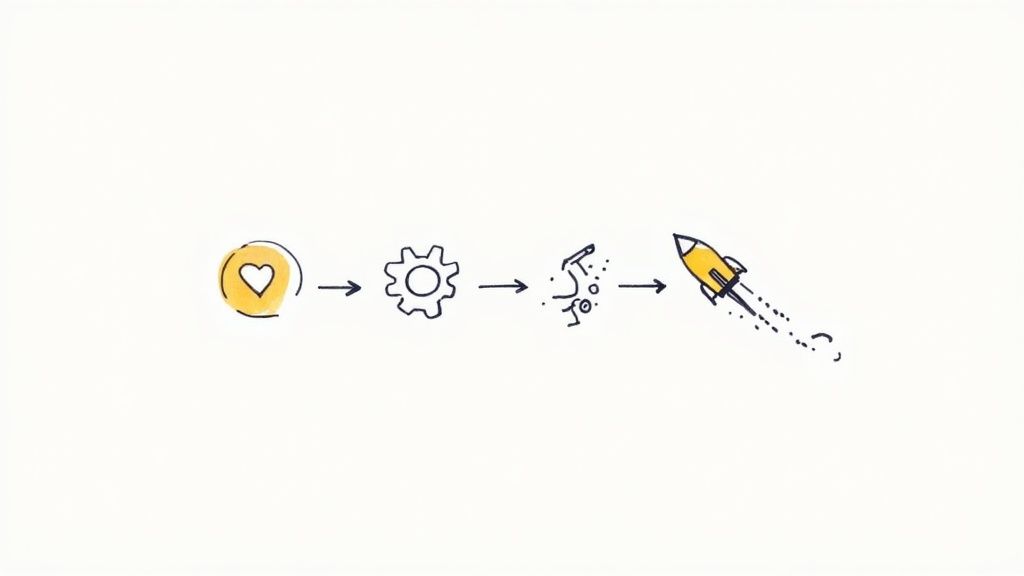Your Guide to Building a Modern CICD Pipeline

Let's be honest, a CI/CD pipeline sounds like complex industry jargon, but the concept is surprisingly straightforward. At its core, it’s an automated process that gets code changes from a developer's machine into production, reliably and efficiently.
Think of it as the ultimate assembly line for your software. Instead of manually passing code from one stage to the next—building, testing, deploying—the pipeline automates the entire journey. It's the engine that powers modern, fast-paced software development.
What Is a CI/CD Pipeline, Really?

To get a real feel for it, imagine your code is in a high-stakes relay race. Every stage of development is a different runner, and the code itself is the baton. The handoff between each runner has to be perfect to keep up the pace and avoid fumbling.
Without a pipeline, that race is pure chaos. A developer might manually hand off their code to a tester, who then passes it over to the operations team for deployment. Each of these handoffs is a chance to drop the baton, leading to painful delays, frustrating bugs, and a whole lot of team friction. A CI/CD pipeline automates these handoffs, turning a clumsy scramble into a smooth, fast, and predictable sprint.
The Core Concepts Driving the Pipeline
The term "CI/CD" isn't just one thing; it’s a combination of three practices that build on each other to create the full pipeline. You really need to understand each part to see how it all clicks together as a cohesive system.
- Continuous Integration (CI): This is all about developers merging their code changes into a central repository, and doing it often. Every time they merge, an automated build and test sequence kicks off. This is huge because it catches integration bugs right away, not weeks later when they’ve become a nightmare to fix.
- Continuous Delivery (CD): This practice picks up where CI leaves off. It takes every validated code change and automatically prepares it for release. The code gets built, tested, and packaged into what we call a "release artifact." The final step—pushing it to live production—is still a manual button press, giving teams a final checkpoint.
- Continuous Deployment (CD): This is where we go full-auto. It takes continuous delivery to its logical conclusion by automatically deploying every single change that passes all the tests straight to production. No human intervention needed. This is how elite teams are able to deploy new code multiple times a day.
To make these concepts even clearer, here's a quick breakdown of how they work together:
Core CI/CD Concepts at a Glance
| Concept | Primary Goal | Key Activity |
|---|---|---|
| Continuous Integration | Find and fix bugs quickly | Automatically build & test code on every commit |
| Continuous Delivery | Always have a release-ready artifact | Automatically prepare every validated build for deployment |
| Continuous Deployment | Release new features faster | Automatically deploy every passing build to production |
As you can see, each step builds on the last, creating a powerful, automated workflow from start to finish.
A well-oiled CI/CD pipeline isn't just about moving faster; it's about building confidence. It’s a safety net that lets your team innovate without fear, because you know the automated quality checks will catch most problems before a user ever sees them.
Why It Solves Critical Development Problems
Before CI/CD pipelines became the norm, software releases were terrifying. They were slow, risky, and incredibly stressful events that everyone dreaded. A modern pipeline tackles these headaches head-on by bringing a systematic, automated approach to the entire process.
This change does more than just fix a workflow; it transforms a team's culture. It shifts development from a place of fear and caution around deployments to one of rapid, iterative improvement. By automating the path from a developer’s commit all the way to a production release, the CI/CD pipeline gives teams the power to ship better software to their users, more often, and with way more confidence.
The Four Core Stages of a CI/CD Pipeline
Every time a developer commits new code, it doesn’t just magically appear in the live application. Instead, it embarks on an automated journey through a series of quality gates. Think of this CI/CD pipeline as a sophisticated, four-stage assembly line, where each step must pass inspection before the next one can begin. It's this structured process that turns raw code into a reliable feature for your users.
This whole flow is designed to accelerate builds, beef up test coverage, and make daily deployments not just possible, but safe.

As you can see, a well-oiled pipeline does more than just connect stages; it adds real, measurable value at each handoff, boosting efficiency in a big way.
Stage 1: The Build
The journey kicks off the moment a developer merges their code. The first stage, Build, is like gathering all the raw ingredients for a recipe. The pipeline’s automation script grabs the human-readable source code and compiles it into a single, executable file or package.
If the code fails to compile—maybe due to a simple syntax error or a missing dependency—the pipeline stops dead in its tracks. This instant feedback is a lifesaver. It prevents a fundamentally broken change from ever moving forward, saving the team from wasting time on code that was doomed from the start.
Stage 2: The Test
Once the application is successfully built, it moves into the Test stage. This is the pipeline's quality control department, where a whole battery of automated tests are thrown at the new build. These aren't just simple checks; a solid pipeline runs multiple layers of tests.
- Unit Tests: These make sure that individual pieces of code, like functions or methods, work correctly on their own.
- Integration Tests: These check that different parts of the application can talk to each other as expected.
- Acceptance Tests: These confirm that the software meets business requirements and works correctly from a user's point of view.
The code only gets a green light if it passes every single test. Just one failure halts the entire process and sends an alert back to the team to fix the problem.
Stage 3: The Release
With a successfully built and thoroughly tested application, the pipeline shifts to the Release stage. Here, the build artifact gets packaged up with its configuration and everything else it needs to run. It's then versioned and stored in an artifact repository—a library of ready-to-deploy versions.
This stage creates what we call an immutable release. The artifact produced here is the exact one that will be deployed, ensuring what was tested is what goes live. This is how you eliminate those "it worked on my machine" headaches for good.
This immutable artifact is now officially a release candidate, ready and waiting for deployment. It's a critical step in Continuous Delivery, making sure you always have a production-ready version on hand. For a deeper look at the habits that make this possible, you can find valuable insights in our guide to continuous integration best practices.
Stage 4: The Deploy
Finally, we arrive at the Deploy stage. This is the moment of truth when the new code goes live. In a Continuous Delivery model, this step might be a manual button-push, giving a product manager the control to time the release perfectly.
In a more advanced Continuous Deployment setup, this stage is completely automated. As soon as the release artifact is ready, the pipeline automatically pushes it to the production environment, making it available to users without any human intervention. This final, automated handoff completes the CI/CD pipeline, delivering value from the developer's keyboard to the customer in one seamless flow.
How a CI/CD Pipeline Drives Business Growth

It’s easy to think of a CI/CD pipeline as just a technical upgrade for the engineering team. But that view misses the bigger picture. In reality, it’s a powerful strategy that directly fuels business growth. By automating the entire path from a line of code to a happy customer, the pipeline becomes the engine for your company’s competitive advantage.
The benefits start with the code but ripple all the way to the bottom line. It fundamentally changes how you innovate and respond to what the market wants.
One of the first things you'll notice is a dramatic improvement in product stability. Let's be honest, manual deployments are scary and notoriously prone to human error, often leading to critical bugs and costly downtime. A CI/CD pipeline nearly eliminates these risks by forcing every single change through a consistent, automated series of checks. This consistency leads to more reliable products, which is a surefire way to boost customer satisfaction and keep them around.
Fostering a Culture of Innovation
Beyond just stability, the rapid feedback loops in a CI/CD pipeline create something even more valuable: a genuine culture of innovation. When developers get feedback on their changes almost instantly, they feel empowered to experiment and iterate with confidence.
The fear that often comes with big, monolithic deployments disappears. Instead, teams are encouraged to try new ideas and ship small, incremental improvements all the time. This ability to quickly test a hypothesis and release a feature gives the business a massive edge. Instead of betting the farm on a massive, high-risk launch that took months to build, teams can roll out smaller updates, measure their impact, and pivot based on what real customers are doing.
This is a fundamental shift that makes the entire organization more nimble. It's even more powerful when you pair your pipeline with broader strategies like these agile development best practices for fast MVPs.
Accelerating Speed to Market
In today’s market, being first can be the difference between leading the pack and eating dust. A CI/CD pipeline is your accelerator, collapsing the time it takes to get valuable new features into the hands of your users.
The core business advantage of a CI/CD pipeline is transforming the software delivery process from a slow, risky bottleneck into a predictable, high-speed asset. It allows you to outpace competitors by consistently delivering value faster.
This accelerated delivery is precisely why so many business leaders are championing the shift. The entire DevOps market, which is tied directly to CI/CD adoption, is projected to hit $25.5 billion by 2028. This growth isn’t just hype; it's driven by leaders who want to slash their release cycles and cut down support time—in some cases by as much as 60%—by adopting proven CI/CD methodologies. We cover many of these continuous integration best practices that drive success in our dedicated guide.
Ultimately, a well-oiled pipeline means higher developer productivity, quicker responses to market changes, and a much stronger position for your business.
Choosing the Right Tools for Your Pipeline
Think of your CI/CD pipeline like an orchestra. It's only as good as the instruments and the musicians playing them. Picking the right tools is critical; the right combination creates a symphony of smooth, automated delivery, while the wrong one leads to a mess of noise and friction. The goal isn’t to find one magic tool but to assemble a toolchain that feels like a natural extension of your team’s workflow.
A modern pipeline isn't a single product. It’s an ecosystem of specialized tools, each playing its part in harmony. From the moment code is written to its final deployment, different tools handle specific stages of the journey. Getting a handle on these categories is the first step to making a smart choice.
Key Tool Categories and What to Look For
The world of CI/CD tools is massive, but thankfully, most fall into a few core categories. When you’re looking at your options, don't just get dazzled by a long feature list. Think about how it will scale, how easily it integrates with the tools you already use, and the strength of its community. A tool with a big, active community means you'll find plenty of documentation, plugins, and helpful answers when you inevitably hit a snag.
A classic mistake is picking a tool just because it’s popular. The best toolchain is one built for your team’s specific needs, languages, and infrastructure. What works for a massive enterprise is often total overkill for a nimble startup.
Let's break down the essential components you'll need to piece together.
- Source Control Management (SCM): This is where everything starts. Your SCM is the single source of truth for your code. Git is the undisputed king here, used by the vast majority of development teams. Platforms like GitHub, GitLab, and Bitbucket sit on top of Git, adding crucial collaboration features like pull requests and issue tracking.
- CI/Build Servers: This is the engine of your pipeline. As soon as code hits your SCM, the build server roars to life, running all your automated build and test stages. Popular choices include Jenkins, which is famous for its incredible flexibility and a plugin for just about anything, and GitLab CI, which is tightly woven into the GitLab platform for a more unified experience.
- Deployment & Merge Automation: This is the critical last mile. Once your code is tested and ready to go, these tools manage its release into the world. This is exactly where a tool like Mergify comes in. It automates the tricky logic of merging pull requests using a merge queue, which is designed to keep your main branch stable and ready for deployment at all times. It can also batch CI runs to save money and prioritize urgent fixes, getting rid of the manual bottlenecks that slow everyone down.
Comparing Popular CI/CD Tools
To give you a better feel for how these pieces fit together, let's look at some of the leading tools side-by-side. This isn't an exhaustive list, but it highlights their main role and where they really shine, helping you think about how to build a powerful CI/CD pipeline.
| Tool | Category | Key Strength | Best For |
|---|---|---|---|
| Git | Source Control | Distributed version control, industry standard for tracking code changes. | Virtually all software development projects, from solo developers to large enterprises. |
| Jenkins | CI/Build Server | Highly customizable with a massive library of plugins for any task. | Teams that need extreme flexibility and have the resources to manage a self-hosted server. |
| GitLab CI | CI/Build Server | Seamlessly integrated into the GitLab SCM platform, simplifying setup. | Teams already using GitLab who want a cohesive, all-in-one development environment. |
| Mergify | Merge Automation | Intelligent merge queue, CI optimization, and automated pull request workflows. | Teams on GitHub looking to eliminate merge conflicts, reduce CI costs, and ship faster. |
Ultimately, the right tools will vary from one team to the next. The key is to understand what each piece does and choose a set of tools that work together to solve your specific challenges, making your entire development process faster, safer, and more reliable.
Essential Best Practices for a High-Performing Pipeline

It’s one thing to have a CI/CD pipeline that works. It’s another thing entirely to have a high-performing strategic asset that sets your team apart. This isn't just about stringing together a few automated steps; it’s about fine-tuning the entire flow to be faster, more reliable, and fundamentally more secure. Get this right, and your pipeline becomes a genuine competitive advantage, boosting developer productivity and your ability to ship quality software.
This drive for optimization is also a big reason why the Continuous Delivery market is booming. Projections show it growing from $4.43 billion to $5.27 billion, as more companies race to build resilient, automated systems. You can see the full market breakdown here to get a sense of the scale.
Keep Builds and Tests Fast
If there's one golden rule for a high-performing pipeline, it’s speed. Simple as that.
When a developer commits their code, they need feedback almost instantly. A pipeline that chugs along for 30 minutes only to report a simple syntax error is a productivity killer. It shatters a developer's focus and grinds momentum to a halt.
Your mantra should be to "fail fast." Structure your pipeline to run the quickest checks first. Things like unit tests and code linting should happen right away, long before you get to the heavier, time-consuming integration or end-to-end tests. This simple change means obvious mistakes are caught in minutes, not hours.
Treat Your Pipeline as Code
Your pipeline’s configuration is just as critical as your application's source code. You absolutely have to store it in a version control system like Git. This practice, known as Pipeline as Code, is non-negotiable for any modern team.
Pipeline as Code makes your entire build and deployment process transparent, versionable, and repeatable. If your CI server goes down, you can rebuild the whole thing from a single configuration file. What could have been a disaster becomes a minor inconvenience.
This approach brings a few major wins:
- Version Control: You can track every single change to your pipeline, see who made it, and roll it back in a heartbeat if something breaks.
- Collaboration: Teams can review and suggest improvements to the pipeline configuration using pull requests, just like they do with application code.
- Reusability: It’s easy to create templates for common pipeline patterns that can be shared across multiple projects, keeping everything consistent.
Shift Security and Quality Left
The concept of "shifting left" is about pulling security and quality checks as early as possible into the development cycle. Instead of waiting for a final, frantic security review right before a release, you build these checks directly into the CI/CD pipeline.
This makes security a shared responsibility, not a last-minute bottleneck.
Incorporate automated tools that scan for vulnerabilities in your code, its dependencies, and even the container images you produce. When you catch security flaws this early, the cost and effort to fix them are drastically lower. The same idea applies to quality—automated code analysis tools can enforce standards and spot potential bugs before a developer even thinks about merging their code.
For a deeper dive, check out our complete guide on the most effective CI/CD best practices.
A Global Look at CI/CD Adoption
The move toward modern CI/CD pipelines isn't just a niche trend; it's a global shift. But if you look closer, you'll see the strategies and market drivers are quite different depending on where you are in the world. This isn't surprising. While everyone wants to ship better software faster, the path to get there is shaped by unique regional challenges—from cloud dominance in one market to mobile-first demands in another.
This global perspective tells us something important: CI/CD is a universal solution, but its application is anything but one-size-fits-all.
North America: The Cloud-Fueled Leader
North America is currently out front in CI/CD adoption, and it’s easy to see why. The region is home to cloud computing titans like Amazon Web Services (AWS) and Google Cloud. This deep-rooted cloud infrastructure created the perfect environment for CI/CD to flourish, giving organizations early access to the scalable, on-demand resources needed to build and run sophisticated automated pipelines.
This head start in the cloud allowed North American companies to weave automation deep into their development cultures long before many others. The result is a market that's both mature and incredibly competitive, with teams constantly pushing the limits of what a CI/CD pipeline can do.
Europe: Pioneering Smarter Pipelines
Across the Atlantic, European teams are carving out their own path. Their focus isn't just on making pipelines faster, but smarter. There’s a serious push in Europe to integrate artificial intelligence (AI) and machine learning (ML) directly into the CI/CD workflow.
The end goal? Self-optimizing pipelines that can predict build failures, flag performance bottlenecks, and even suggest fixes without a human stepping in. It’s a forward-thinking approach aimed at cutting down the manual effort needed to keep a pipeline healthy, freeing up developers to build great features instead of wrestling with their tools.
The global continuous delivery landscape shows clear regional differences in growth and focus. North America currently holds the largest market share at 36.0%, but other regions are catching up fast with impressive growth rates.
Europe, for instance, is showing strong growth, but the Asia Pacific region is expanding even more rapidly. You can dive deeper into these continuous delivery trends and market predictions to get the full picture.
Asia Pacific: Explosive Mobile-First Growth
The Asia Pacific (APAC) region is seeing an explosion in CI/CD adoption, and it’s all being driven by one powerful economic force: its mobile-first economy. In many APAC countries, smartphones aren't just one way people interact with digital services—they're the primary way. This reality puts enormous pressure on companies to deliver frequent, flawless updates to their mobile apps.
A rock-solid CI/CD pipeline is the only way to keep up with that kind of demand. It enables the rapid, iterative release cycles that are absolutely necessary to compete in such a fast-paced mobile market. This has turned the region into a hotbed for CI/CD innovation, with an expected compound annual growth rate of 21.1%—outpacing other regions as businesses scramble to automate their mobile delivery workflows.
Common Questions About CI/CD Pipelines
As teams start to get their hands dirty with CI/CD, a few questions pop up almost every time. It's easy to get tangled in all the jargon and technical details, so let's cut through the noise and clear up a few common points of confusion.
First up, what’s the real difference between Continuous Delivery and Continuous Deployment? It trips a lot of people up, but the distinction is actually pretty simple.
- Continuous Delivery: Think of this as automating everything up to the final release. The pipeline builds, tests, and packages your code, leaving a release-ready artifact waiting for a final, human "go-ahead." It's a manual safety switch that gives you control over when something goes live.
- Continuous Deployment: This takes that last step and automates it too. Once a change passes all the tests, it’s pushed directly to production. No human intervention needed.
For most teams just starting out, Continuous Delivery is the way to go. It gets you all the benefits of automation while still keeping a person in the loop for that final decision.
Where Should a New Team Start?
Building a pipeline from scratch can feel like a massive undertaking. My advice? Start small and scale slowly. The goal isn't to automate everything at once. Instead, focus on nailing down your Continuous Integration (CI) process first.
The most crucial first step is to automate your build and unit tests. This one change creates a fast feedback loop for your developers. It catches simple bugs and integration hiccups in minutes instead of days, forming the bedrock for everything else you'll build.
Once your CI is running smoothly, you can start layering on more stages. Add a step to package your application. Then, introduce some integration tests. By adding complexity piece by piece, you build a solid CI/CD pipeline without getting buried in the process.
How Do You Measure Success?
So, how do you know if all this effort is paying off? While pipeline speed is a factor, real success is measured by how it impacts your team's stability and output. It’s not just about going fast; it’s about going fast safely.
Here are the key indicators to watch:
- Deployment Frequency: How often are you pushing code to production? The best teams often release multiple times a day.
- Lead Time for Changes: How long does it take for a line of code to go from a developer's machine to production? Shorter times mean you're delivering value to users faster.
- Change Failure Rate: What percentage of your deployments break something? A low failure rate is a sign of a trustworthy, reliable pipeline.
Tracking these numbers gives you a clear, data-backed picture of your pipeline’s health and its true impact on how you build software.
Ready to eliminate merge bottlenecks and optimize your CI process? Mergify automates your pull request workflows with an intelligent merge queue, CI optimization, and insightful analytics. Start shipping faster and safer today.





